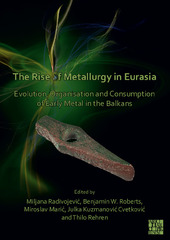Приказ основних података о документу
Ground and abrasive stone tools from Pločnik
| dc.creator | Dimić, Vidan | |
| dc.creator | Antonović, Dragana | |
| dc.date.accessioned | 2023-11-23T10:30:04Z | |
| dc.date.available | 2023-11-23T10:30:04Z | |
| dc.date.issued | 2021 | |
| dc.identifier.isbn | 978-1-80327-042-5 | |
| dc.identifier.isbn | 978-1-80327-043-2 | |
| dc.identifier.uri | http://rai.ai.ac.rs/handle/123456789/822 | |
| dc.description.abstract | This analysis of ground and abrasive stone tools from Pločnik is based on the examination of assemblage of artefacts found during 2012 and 2013 in Trench 24. The assemblage is very characteristic of the Vinča culture and spans Vinča Tordoš I (Vinča A) to the Gradac Phase (Vinča B2–C1) when occupation at Pločnik terminated in a great destructive fire. We analysed more than 100 artefacts but selected for detailed study only those finds with a clear context; 72 artefacts are discussed here. A large number (41) of large abrasive tools (static grindstones, grinders and querns made of various types of sandstone of local origin) were not included in this study because of their unclear context. As with the Belovode assemblage, the ground and abrasive stone tools were classified according to the production method of the tools and their typological and functional features. The typological analysis was based on general observations and the correlation of metric characteristics of certain tools and their place within the methodological framework established by Antonović (1992, 2003, 2014c). Tool function was examined through the correlation of morphological characteristics and visible traceological markers for all tools with minimum preserved evidence (Semenov 1964; Olausson 1983a, 1990; Adams 1988; 1989; 2002; Adams et al. 2009; Pritchard-Parker and Torres 1998; Plisson and Lompre 2008; Pawlik 2007; Lunardi 2008; Antonović 1992: 20–23; Dimić 2013a, 2015). In addition to specific use-wear traces, other production marks were also recorded, providing indications of the methods and processing techniques used by Pločnik craftspeople for different types of rock. All analyses were carried out at the Institute of Archaeological in Belgrade using magnifying glasses with up to 16× magnification and a stereo microscope (Olympus®) with up to 100× magnification with a connecting camera. | sr |
| dc.language.iso | en | sr |
| dc.publisher | Oxford: Archaeopress | sr |
| dc.relation | The Rise of Metallurgy in Eurasia (funded by the UK Arts and Humanities Research Council (AHRC) | sr |
| dc.rights | openAccess | sr |
| dc.rights.uri | https://creativecommons.org/licenses/by-nc-nd/4.0/ | |
| dc.source | The Rise of Metallurgy in Eurasia: evolution, organisation and consumption of early metal in the Balkans. | sr |
| dc.subject | Neolithic | sr |
| dc.subject | Serbia | sr |
| dc.subject | Pločnik site | sr |
| dc.subject | Polished stone tools | sr |
| dc.subject | Abrasive stone tools | sr |
| dc.subject | analyses | sr |
| dc.subject | manufacture and use | sr |
| dc.subject | archaeotechnology | sr |
| dc.title | Ground and abrasive stone tools from Pločnik | sr |
| dc.type | bookPart | sr |
| dc.rights.license | BY-NC-ND | sr |
| dc.rights.holder | sr | |
| dc.citation.epage | 392 | |
| dc.citation.spage | 382 | |
| dc.description.other | In: Radivojević, M., Benjamin W. Roberts, B. W., Marić, M., Kuzmanović Cvetković, J.,and Rehren, T. (eds.), The rise of metallurgy in Eurasia: Evolution, organisation and consumption of early metal in the Balkans, pp: 382–392. Oxford: Archaeopress. | sr |
| dc.identifier.doi | 10.32028/9781803270425 | |
| dc.identifier.fulltext | http://rai.ai.ac.rs/bitstream/id/1870/bitstream_1870.pdf | |
| dc.type.version | publishedVersion | sr |


